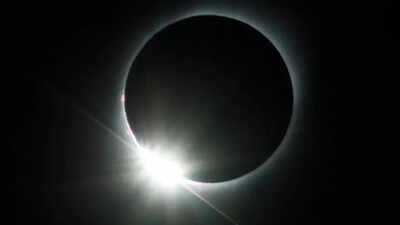ARTICLE AD BOX

On August 2, 2027, a remarkable total solar eclipse will darken the skies over parts of Europe, North Africa, and the Middle East. For up to 6 minutes and 23 seconds, the Moon will completely obscure the Sun, casting a dramatic shadow over Earth in what is being called the “Great North African Eclipse.” This event will be the longest total solar eclipse visible from land between 1991 and 2114. With such an extended period of totality and broad visibility, this eclipse will be a once-in-a-lifetime experience for millions of people across continents.Clear skies are expected in many parts of North Africa, particularly in Libya and Egypt, which are renowned for their dry, sunny weather in August. These favourable conditions enhance the likelihood of an unobstructed view, making the region ideal for eclipse observation and tourism.
Solar Eclipse in August 2027: Date and time
The total solar eclipse will occur on Monday, August 2, 2027, during the early to mid-afternoon hours, depending on your location.
- In Southern Spain, totality is expected to begin around 13:30 to 14:00 local time (CEST).
- In North Africa, such as Libya and Egypt, the eclipse will peak around 14:00 to 14:30 local time (EET).
- In Saudi Arabia, the eclipse will reach totality slightly later in the day, around 15:00 local time (AST).
Exact timings may vary by a few minutes depending on the observer’s precise location along the path of totality. The full eclipse duration, from first contact (partial eclipse begins) to final contact (partial eclipse ends), will last approximately 2.5 to 3 hours, with totality lasting up to 6 minutes and 23 seconds in select areas like Luxor, Egypt.
What makes the 2027 solar eclipse so special
Unusual celestial alignmentThree rare astronomical conditions will occur simultaneously to produce such a long eclipse:
- Earth at Aphelion: On August 2, Earth will be at its farthest point from the Sun. This makes the Sun appear slightly smaller in the sky.
- Moon at Perigee: At the same time, the Moon will be at its closest distance to Earth, making it look larger than usual.
- Equatorial Shadow Path: The eclipse will travel close to the equator, where the Earth's rotational speed causes the Moon’s shadow to move more slowly across the surface. This slower movement prolongs the duration of totality.
These combined factors will result in a total solar eclipse lasting over six minutes, significantly longer than most eclipses, which typically range from two to three minutes.
Solar Eclipse 2027 visibility
The eclipse will begin over the Atlantic Ocean and move eastward across Europe, Africa, and the Middle East. The path of totality, which is the narrow band where the eclipse will be fully visible, will be approximately 258 to 275 kilometers wide.
Europe
- Southern Spain, including cities such as Cádiz and Málaga, will experience total darkness for over four minutes. The eclipse will make landfall at the Strait of Gibraltar.
North Africa
- Northern Morocco, particularly Tangier and Tetouan, will be directly beneath the central shadow.
- Parts of Algeria and Tunisia will also be in the path.
- In Benghazi, Libya, totality will last nearly five minutes.
- Central Egypt, especially near Luxor, will experience more than six minutes of total darkness.
- Northeastern Sudan will also fall under the path of totality.
Middle East and Horn of Africa
- The eclipse will pass over southwestern Saudi Arabia, including cities such as Jeddah and Mecca.
- Portions of Yemen and northeastern Somalia will also witness totality.
Indian Ocean
- The eclipse will exit over the Indian Ocean and continue past the Chagos Archipelago before fading.
Regions what will miss the eclipse
The 2027 eclipse will not be visible in many parts of the world, including:
- India and much of South Asia
- North and South America
- Most of East Asia and Australia
Observers in these regions may not witness any part of the eclipse or will only experience a minor partial eclipse.
August Solar Eclipse: Historical and scientific significance
The upcoming 2027 eclipse is not the longest in history, but it is the most significant of this century. The longest recorded total solar eclipse occurred on June 15, 743 BC, lasting 7 minutes and 28 seconds. However, the 2027 event will be the longest visible from land between 1991 and 2114. The next similarly long eclipse will not take place until August 23, 2114.This event is significant not only because of its rare duration but also because of its wide visibility across multiple countries. Scientists, astronomers, and casual observers alike will benefit from the opportunity to study the Sun’s corona and other solar phenomena during the extended period of totality. For those living near the eclipse path, it is a truly once-in-a-century opportunity. The combination of scientific importance and natural beauty makes this a date worth marking in calendars worldwide.Also Read | How much did ISRO spend to send Shubhanshu Shukla to the ISS on historic 18-day Axiom-4 mission



.png)
.png)
.png)
















 4 hours ago
3
4 hours ago
3









 English (US) ·
English (US) ·